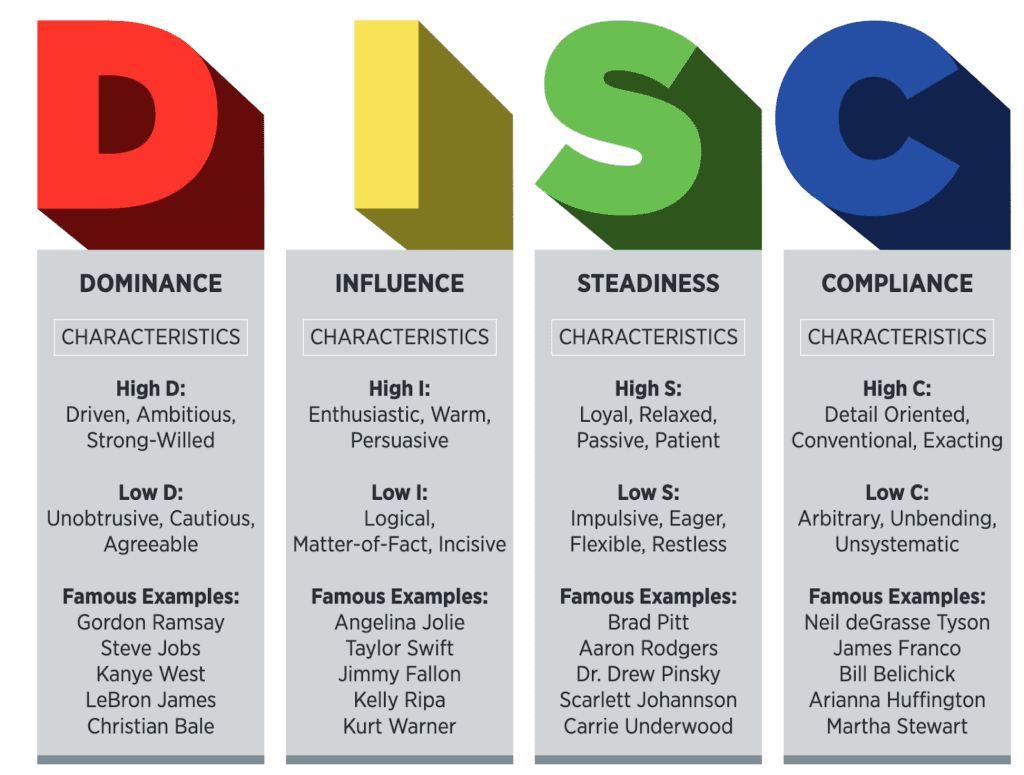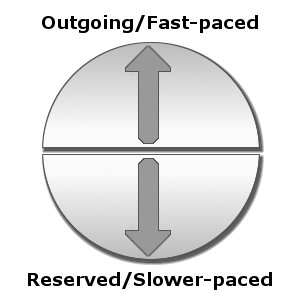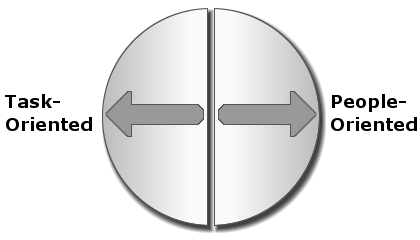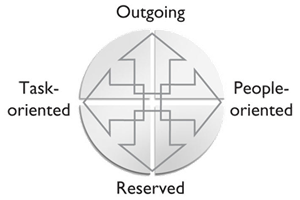
What is the DISC Behavioral Model?
The DISC Behavioral Model describes an individual’s characteristics, communication preferences, and motivation as observable behaviors.
Recognizing observable behaviors in others can help you communicate more effectively and build stronger relationships, personally and professionally.
Dr. William Marston theorized that people are motivated by two key motivators that direct human behavioral patterns: the Motor Drive (or Pace Driver) and the Compass Drive (or Priority Driver).
The Motor/Pace Driver
If you divide a circle in half horizontally, the upper half represents outgoing or fast-paced people. The lower half represents reserved or slower-paced people.

Outgoing people tend to move fast, talk fast, and decide quickly.
Reserved people tend to speak more slowly and softly and generally prefer to consider things carefully and thoroughly before deciding.
Remember that these descriptions of behaviors are tendencies rather than absolutes. Depending on the situation, most people will exhibit a bit of both of these Traits.
Even so, most people will exhibit more of one Trait over the other – even if it is slightly more.
The Compass/Priority Driver

Now, divide the circle vertically. The left half represents task-oriented people, and the right represents people-oriented individuals.
Task-oriented people focus on logic, data, results, and projects.
People-oriented individuals focus on experiences, feelings, relationships, and interactions with others.
The Four DISC Behavioral Styles
When you combine the drawings for the Motor and Compass drives, you get the circle of expected behaviors and perspectives divided into four quadrants.

The DISC circle represents the full graphical description of what is commonly referred to as The DISC Model of Human Behavior.
Each quadrant of the DISC circle has descriptive words attached to it.
These descriptive words attempt to capture the typical behavior traits or tendencies people exhibit with the combination of motor and compass drives corresponding to that quadrant.
They are often called a behavioral type or style to make discussing the quadrants easier.
While using the phrase “personality type” with this model is not strictly or technically accurate from a clinical psychology standpoint, it is often used in everyday conversation.
So, the term Behavioral Style is preferred because it more accurately fits the model and its theory.
The Dominant Style

Dominant Style people are Fast-paced and Task-oriented.
They are most interested in the big-picture goals, objectives, tasks, and results.
Dominant people are self-starters, direct, and decisive; they will challenge the status quo, prefer to lead rather than follow, and tend towards leadership and management positions.
Dominant people are highly self-confident, risk-takers, and problem-solvers, enabling others to look to them for decisions and direction.
Dominant Personality Type cross-reference
- Keirsey Type – Rationals
- Temperament Type – Choleric
- Animal Type – Lion
- Socio-Communicative Type – Driver
- True Colors – Green
- Color Code – Red
- Personality Compass – North
- Occupational Type – Enterprising
- Learning Type – Activist
- Leadership Type – Dominator
MBTI Personality Types (xNTx) – Intuition and Thinking
Enneagram Types
- Type 1 – The Reformer (ENTJ, INTJ)
- Type 3 – The Achiever (ENTP)
- Type 5 – The Investigator (INTJ, INTP)
- Type 7 – The Enthusiast (ENTP)
- Type 8 – The Challenger (ENTJ)
Learn more about the DISC Dominant Behavior Style.
The Influencer Style

Influencer Style people are Fast-paced and People-oriented.
They are enthusiastic, optimistic, talkative, persuasive, impulsive, and emotional.
Influencer people emphasize bringing others into an alliance to accomplish results and prefer to focus on relationships over tasks.
They will trust others naturally, truly enjoy being around others, and function best when around people and working in teams.
Influencer people are not afraid to be the center of attention.
Influencer Personality Type cross-reference
- Keirsey Type – Idealists
- Temperament Type – Phlegmatic
- Animal Type – Otter
- Socio-Communicative Type – Expressive
- True Colors – Blue
- Color Code – Blue
- Personality Compass – West
- Occupational Type – Artistic
- Learning Type – Theorist
- Leadership Type – Collaborator
MBTI Personality Types (xNFx) – Intuition and Feeling
Enneagram Types
- Type 1 – The Reformer (ENFJ, INFJ)
- Type 4 – The Individualist (INFJ, INFP)
- Type 7 – The Enthusiast (ENFP)
- Type 9 – The Peacemaker (INFP)
Learn more about the DISC Influencer Behavior Style.
The Compliant Style

Compliant Style people are Slow-paced and Task-oriented.
They are accurate, precise, detail-oriented, conscientious, and prefer structure and order.
Compliant people think analytically, systematically, and carefully make decisions supported by ample research and information.
They tend to be perfectionistic and have high standards for themselves and others.
Because they focus on the details and see what many other styles do not, they tend to be good problem solvers and very creative people.
Compliant Style Personality Type cross-reference
- Keirsey Type – Guardian
- Temperament Type – Melancholy
- Animal Type – Beaver
- Socio-Communicative Type – Analytical
- True Colors – Gold
- Color Code – White
- Personality Compass – East
- Occupational Type – Realistic
- Learning Type – Pragmatist
- Leadership Type – Avoider
MBTI Personality Types (xSxJ) – Sensing and Judging
Enneagram Types
- Type 1 – The Reformer (All Judging)
- Type 2 – The Helper (ESFJ, ISFJ)
- Type 6 – The Loyalist (All Sensing)
- Type 8 – The Challenger (ESTJ)
Learn more about the DISC-compliant behavior style.
The Steady Style

Steady Style people are Slow-paced and People-oriented.
Steady people emphasize cooperating with others to carry out a task and prefer to work as part of a team rather than alone.
They are stable, predictable, even-tempered, friendly, sympathetic with others, and very generous with loved ones.
Steady Style Personality Type cross-reference
- Keirsey Type – Artisans
- Temperament Type – Sanguine
- Animal Type – Golden Retriever
- Socio-Communicative Type – Amiable
- True Colors – Orange
- Color Code – Yellow
- Personality Compass – South
- Occupational Type – Conventional
- Learning Type – Reflector
- Leadership Type – Accommodator
MBTI Personality Types (xSxP) – Sensing and Perceiving
Enneagram Types
- Type 2 – The Helper (ESFP, ISFP)
- Type 6 – The Loyalist (All Sensing)
- Type 7 – The Enthusiast (ESTP, ESFP)
- Type 9 – The Peacemaker (ISFP)
Learn more about the DISC Steady Behavior Style.
Personality Temperaments, Traits, and Types
Personality Temperaments, Personality Traits, and Personality Types are used in Psychology to discuss a person’s Personality, a collection of Emotions, Perceptions, and Actions that interact with each other, regulate themselves, and shape a dynamic system that forms a person’s Behavioral Patterns.
Your inherited traits (your personality Temperance) and acquired traits (such as education, socialization, and other various pressures and aspects) form your Personality.
A Personality Type identifies a specific collection of Traits, both learned and natural, that comprise a broad, general Personality Classification—a way of labeling a collection of traits and behaviors.
A Personality Trait remains consistent and stable over time, which means you exhibit the same pattern across different situations and throughout your life.
Three criteria characterize Personality Traits: (1) consistency, (2) stability, and (3) individual differences. For example, if you are talkative at home, you also tend to be talkative at work. And if you were talkative at age 20, you would still be chatty at age 40.
Personality Temperament is your “Naturally Intuitive” biological Trait. These Traits are partly inherited from your genes and partially determined by your brainstem, which doesn’t change throughout your life. These are Natural Traits regarded as innate or inborn and not learned.
Your Personality Temperament is formed as an infant and is hard to modify, manipulate, or change because it is genetic. In some way or another, your inherited behavioral tendency will always be there.
Personality Traits are quantitative differences between people, and Personality Types are qualitative differences between people. The most crucial difference between the Trait Theory and the Type Theory is that the Type Theory views people’s characteristics as discrete categories. In contrast, the Trait Theory views these characteristics as a continuum.
For example, while a Type Theorist would claim that introverts and extraverts are two types of people, a Trait Theorist claims that extraversion is a gradient, and individuals can fall somewhere in the middle.
Your Temperaments, along with acquired Traits, form your Personality.



